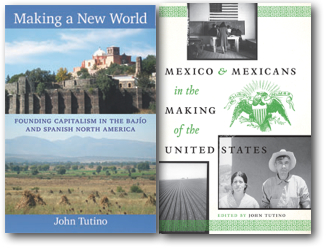|
 Book Review
by C.M. Mayo Book Review
by C.M. Mayo

MAKING A NEW
WORLD: FOUNDING CAPITALISM IN THE BAJIO AND SPANISH NORTH AMERICA
 By John Tutino By John Tutino
Duke
University Press, 2011
ISBN 978-0-8223-4989-1
MEXICO AND THE
MEXICANS IN THE MAKING OF THE UNITED STATES
Edited by John Tutino
University
of Texas Press, 2012
ISBN 978-0-292-73718-1
 Review originally published in Literal 34,
2013 Review originally published in Literal 34,
2013
The Bajío, a rich agricultural,
mining and industrial region north
of Mexico City, does not even appear on most English-speaking
peoples' mental maps of Mexico. North of the U.S.-Mexico border,
the best word to describe the image of Querétaro, the
Bajío's first and still thriving major city, would probably
be "obscure." And yet Querétaro, founded by
Otomís and Franciscan friars in 1531, may be the hometown
of capitalism— so argues John Tutino in Making
a New World: Founding Capitalism in the Bajío and Spanish
North America, a nearly 700 page tour de force of original
research heavy with appendices, yet with such a wealth of novelistic
detail, the reading itself trips along like a novel.
While not denying the role of
England and its North Atlantic colonies, Tutino points out that
because they dominated the capitalist world after 1800, the origins
and nature of what preceded it—sparked by Ming China's demand
for silver and Spain's American colonies' ability to provide
it—have been overlooked. The main early silver mines in
the 16th century were Potosí in South America and Zacatecas,
in the Bajío north of Mexico City. It was this nexus out
of which flowered the international trade and culture of capitalism.
The "enduring presumption" that capitalism was "Europe's
gift to the world (or plague upon it)," is the first Tutino
explodes, and the second, that the conservative nature of Spanish
Catholic culture could not nurture the innovation and creativity
necessary for true capitalism, he attacks with a few life stories
from the early days in the colonial Bajío, as it was expanding
beyond traditional farming and mining into a more intricate and
internationally connected commercial society. He gives their
names, describes their accomplishments in trade, mining, farming,
and various social honors and donations to the church, yet, to
the reader's undoubted surprise, one is Otomí, one most
likely descended from African slaves, and another, an Italian
count. Tutino asserts:
"[T]the Bajío and
Spanish North America were not ruled by a dominant Spanish state;
they were not led by men more interested in honor than profit;
they did not organize work mostly by coercion. Life was not ruled
by rigid castes; communities were no constrained by an imposed
Catholicism that inhibited debate. They were instead societies
founded and led by powerful, profit-seeking entrepreneurs of
diverse ancestry."
This dynamism of the Bajío
and Spanish North America and its vital importance for understanding
North American, and therefore the United States history itself,
is reprised in Tutino's anthology, Mexico
and Mexicans in the Making of the United States, with
his essay, "Capitalist Foundations: Spanish North America,
Mexico, and the United States."
The anthology departs from and
explores the view that, to quote from Tutino's introduction:
"Mexicans are not 'invaders'
of the United States. Rather, Mexico and Mexicans have been and
remain key participants (among many and diverse peoples) in the
construction of the United States- our prosperity, our power
in the world, our promise of inclusion, even our ways of segmentation
and exclusion."
Andrew Isenberg's "Between
Mexico and the United States: From Indios to Vacqueros in the
Pastoral Borderlands," offers a fascinating look at one
of the indigenous responses to Spanish Conquest, to adopt Old
World livestock—sheep, cattle and horses— and how that
changed the societies themselves in the complex interplay with
each other, with Mexicans, and with an encroaching United States.
David Montejano's "Mexican Merchants and Teamsters on the
Texas Cotton Road, 1862-1865," examines the role of "Mexican"
cotton, that is, Confederate cotton re-labeled for export to
avoid the Union blockade, in both the ability of the South to
fight for as long as it did, and in the rise of Monterrey, Mexico's
major northern commercial city.
As for shaping ideas of Mexico and Mexicans in the U.S. imagination,
Shelley Streeby delves into the profound influence of now forgotten
novels such as Magdalena: The Beautiful Mexican Maid and
The Female Warrior, whose heroine, a belle from Mobile,
ends up imprisoned in Mexico City, menaced by the nefarious and
romantically inclined tyrant, Santa Anna.
Especially insightful is Ramón Gutiérrez's look
at New Mexico's concept of mestizaje, which he argues is a key
contribution to the making of North America, bringing it beyond
polarities of white and black.
As Tutino notes, "Too often we presume that rapid 'Americanization'
shaped the borderlands, drowning Mexican ways and peoples. Yet
every careful analysis shows a more complex, interactive, adaptive
history from Texas to California." Both his Making a New
World and the several essays in this anthology suggest the dazzling
richness of still untold shared histories.
Listen to my Marfa Mondays podcast interview with John Tutino,
"Looking
at Mexico in New Ways"
Main
(Notes)
+ Podomatic + iTunes + Transcript

(APPROX
1 HOUR AND 15 MINUTES) |



